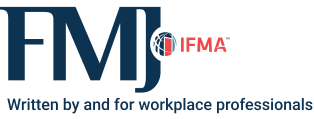On Standards
The Right Fit: Selecting a management system standard
In the rapidly evolving world of facility management, for which the only reliable forecast is more transformation, management system standards should be a welcome change for today’s facility managers.
Based on the plan-do-check-act cycle, management system standards provide relevant specifications for organizations to demonstrate their capability to meet internal and external requirements.
Management system standards require FM teams to focus on operations and
processes, thus enabling efficiencies. They enable facility managers to focus on strategies that reduce costs by minimizing waste and errors and increase productivity.
A 2012 study by the International Organization for Standardization (ISO) documented three key benefits realized by companies small and large that use standards. These companies can:
-
streamline internal operations.
-
innovate and scale up operations.
-
and even create or enter new markets.
Imagine for a minute a life with no standards. What if no one asked for metrics or benchmarks before approving a budget? What if there were no processes or policies to follow and no data to maintain? Life for facility managers would be easy — or at least easier. In a world with no budget or time constraints, FMs could perform reactive maintenance and replace assets deteriorating before reaching the end of their useful service life without concern for cost, lost revenue or downtime.
Each FM would be free to use any self-invented terminology, like naming chillers after planets or exotic animals (think of Apple’s operating system names: Puma, Jaguar, Snow Leopard, etc.). Life would be dreamy…or would it?
Today’s facility managers face unprecedented challenges. In a profession already saturated with competing priorities and investment options, why would any organization voluntarily self-impose a complex and potentially costly management system standard?
Without standards, it would be impossible to compare performance to that of other organizations or even across the industry. There would be no foundation to learn about what other organizations are doing that may be best practices, and organizations may not be able to determine the best capital investment options, since there would not be a standard in place to support decision making. Without standards, we may as well use “eeny, meeny, miny, moe” as the foundation of decision-making processes.
So many standards for FMs; so little time
The development of internal procedures and the process for systemizing how activities are performed within an organization is a management system. The benefits of management system standards include improved communication of requirements and methodologies among and between public- and private-sector organizations, improved service consistency, and hence, reduced risk to buyers and a common platform for small businesses and those from developing economies. For businesses, they are strategic tools that reduce costs by minimizing waste and errors, while also increasing productivity.
There are several ISO management system standards (MSS) available for use by facility mangers; the purpose here is to highlight a few that impact facility management. When evaluating which one to implement, a good rule of thumb is to consider the organization’s business objectives, then consider which MSS will help support the organization’s achievement of those goals. When implemented, applied and certified, management system standards can improve profitability, quality, service, organizational performance, client loyalty, brand reputation and much more. Here are a few standards to consider:
ISO 9001 Quality Management
Customer satisfaction is the cornerstone of ISO 9001. This MSS is grounded in the concept of continual improvement and is applicable to both product- and service-based enterprises. The standard guides organizations in identifying their customers all those affected by the work performed by the organization and the expectations they have.
Quality is important to all organizations hoping to maintain a customer base, whether this is internal or external. ISO 9001 outlines the requirements for establishing a quality management system to control and manage organizational processes to increase customer satisfaction.
Efficiency is another focus of the quality management system. Efficient operations mean better process flow and control, with processes defined, aligned and understood by the whole organization as contributing to higher productivity and lower costs.
ISO 50001 Energy Management System Standard
Escalating energy costs and shifting environmental regulations are a challenge to any organization. ISO 50001 is the management system standard for designing an energy policy that enables each organization to maximize the effectiveness of its consumption.
The standard requires the development of an energy management plan that identifies and analyzes regulatory requirements, evaluates existing energy use and determines the energy baseline for the organization. Following the development of a policy and management plan, it guides implementation to initiate control measures over all high-energy consumption activities, information integration, document control and training curricula within the organization.
The implementation is where the rubber meets the road, and finally, where measuring and monitoring energy use, process and policy compliance, and legislative changes will ensure the energy management system continually meets goals and efficiency targets but also identifies areas for improvement of the overall energy efficiency of the facility. Following ISO 50001, organizations will be able to determine which additional opportunities align with business goals and criteria when integrated into the energy management system.
When the organization’s core objectives are to conserve resources, positively impact climate change and save money, understanding what energy is being used and where it is being used through the implementation of this MSS enables facility managers to implement operational controls for efficiency and reduce energy waste while remaining compliant with regulatory laws and legislation changes. The identification and management of risks to rising energy costs and supply shortages is another benefit of developing an energy management system.
ISO 14001 Environmental Management System Standard
Efficient use of resources and reduction of waste are of concern to every facility manager, and no professional is better positioned to understand and manage the relationship between natural resources and the environmental impact of every facility. The updated environmental MSS helps organizations align with current regulatory requirements and provides greater focus on the assimilation of environmental issues into the business management realm (both an inward and outward assessment), including employee and leadership engagement and supply chain management.
ISO 14001 steers organizations through the environmental performance labyrinth while maintaining the full life cycle, holistic approach. The environmental MSS aligns environmental performance with organizational objectives and strategic initiatives. This standard is framed under the same guidance structure that flows parallel to the plan-do-check-act format and incorporates identify, manage, monitor and control.
As with all ISO management system standards, the effect of implementing the ISO 14001 is realized in cost reductions and efficiency improvements. Companies whose brand is tied to strong corporate social responsibility initiatives will benefit from implementing this standard as it can result in a positive social impact.
ISO 55001 Asset Management System Standard
The new international asset management standard, released in 2014, focuses on the full life cycle of facilities. The asset management system provides a framework for controlling, aligning, collaborating, optimizing and continually improving the processes for managing physical organizational assets. Optimizing the delicate balance between risk, cost and performance against organizational objectives and operational priorities can reduce the total cost of ownership, as well as provide an increase in reliability and operational stability for physical assets.
ISO 55001 is intended to organize the continual improvement phases of the asset management system. Implementing an asset management strategy requires a holistic enterprise transformation built on a foundation of organizational context, leadership, planning, support, operation, performance evaluation and continual improvement. This MSS describes the procedures required to meet the organizational objectives for managing the full life cycle of physical assets. It outlines what needs to be done, while leaving the development of how it needs to be done to each organization to determine.
More mature organizations that are ready to consider their operations and assets from a cradle to grave perspective will benefit from implementing ISO 55001.
ISO 22301 Societal Security: Business Continuity Management System Standard
Whether it is an act of terrorism or a natural catastrophe, unexpected disasters can strike at any time. Because facility managers have responsibility for so much of the built environment, contingency planning and disaster recovery are familiar terms.
The advancement of these responsive plans has evolved into business continuity management (BCM) — a business led process for mitigating the adverse effects of disruptive events on society. The BCM MSS addresses a larger purview than just the internal organizational procedures during an emergency and includes considerations such as supply chain continuity, business partner continuity alignment and a plan for return to normal business operations.
Performance against plan, as well as continual improvement, are both requirements of this and all management system standards. Functional tests to validate continuity are required and may already be part of a facility manager’s emergency preparedness and operability plan, such as emergency generator testing.
There is no organization that cannot benefit from a plan that focuses on recovery from disruptive events, but if the organization’s core objectives are focused on maintaining service delivery through all supply chains, this standard is the right one.
ISO 26000 Guidance on Social Responsibility
Facility managers across the globe are becoming increasingly aware of the need to operate in a socially responsible manner, including organizational policies and processes for operating and maintaining facilities. Businesses are dependent on the social and environmental networks that provide the opportunity for the organization to pursue their business mission. ISO 26000 provides a tool to assist organizations in developing operation and management models that contribute to a healthy environment, social equity and sustainable organizational processes.
As more organizations enter the international facility management zone, it is important to understand not only social, environmental, legal, political and cultural considerations, but also alignment with acceptable international norms and behaviors toward social responsibility. The seven core guidance sections within the standard include human rights, labor practices, the environment, fair operating practices, consumer issues, and community involvement and development.
Because ISO 26000 is not a management system standard and does not contain requirements, it cannot be certified against. It can, however, be valuable for understanding social responsibility and identifying stakeholders within the sphere of influence of the organization. Once these two fundamental issues have been realized, the standard provides additional guidance for integrating social responsibility throughout the organization and contributes to sustainable development.
In partnership with ISO 14001 or ISO 50001, this guidance standard enables an organization to build a solid brand around a message of corporate social responsibility.
Why should FMs use standards?
The benefits of using international standards for facility managers are wide ranging. From economic and performance improvements to best practice implementation and industry standardization — there are aspects of every management system standard that can help facility managers align with business priorities, provide decision making support to executive management, increase credibility and confidence from customers and stakeholders, prepare for unexpected events and realize continuous improvement.
The allocation of precious time and resources is well worth the effort of developing and implementing a management system, whether choosing to use a third party or taking a do-it-yourself approach. The investment in developing organizational standards, even without seeking certification, not only results in more efficient operations and management of facilities, but also contributes to improved total cost of ownership, positive social impact and sustained business continuity.
Developing FM standards
The FM profession has a direct impact on the productivity of every individual who works in and around buildings and infrastructure. FM also plays a role in the security and quality of life of people around the world. Beginning in February 2014, ISO Technical Committee 267, chaired by Stan Mitchell representing the British Standards Institute, began work on an FM management system standard. ISO 41001 will enable “an organization to be able to demonstrate that it has a robust process through which to design, manage and improve its integrated facility management system.”

Laverne Deckert is an Independent consultant, working with organizations to creatively respond to their challenges. She has led research, educational programs, standards, and community development initiatives in the corporate real estate and FM industry. Her primary goal is to bring value to every interaction. Her colleagues value her curiosity and creativity, ability to organize complex information, to facilitate teams in meaningful collaboration, and her focus on strategic goals. Deckert currently as Administrator for the U.S. Technical Advisory Group Administer on behalf of the American National Standards Institute (ANSI) for ISO/TC 267 and as the convenor for ISO/TC 267/AG 1 – Roadmap Advisory Group.

Casey Martin has more than 20 years of building industry experience and is currently engaged in the asset management strategies practice at Jacobs Engineering. In this role, she consults with private and U.S. federal institutions, providing full life cycle perspectives throughout project development stages. Her approach considers important long-term views such as total cost of ownership, reliability-centered maintenance practices, operation strategies, and processes and policies to align asset management with business and mission objectives.
References
www.iso.org/iso/benefits_of_standards.html
Read more on Standards , Leadership & Strategy and Sustainability
Explore All FMJ Topics






